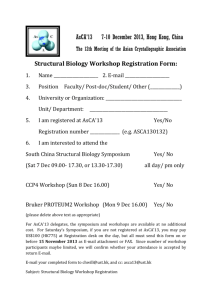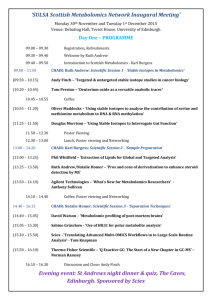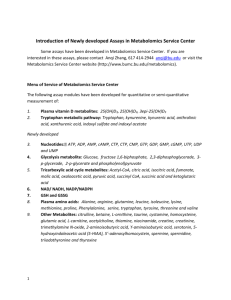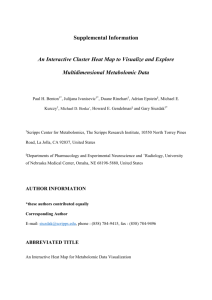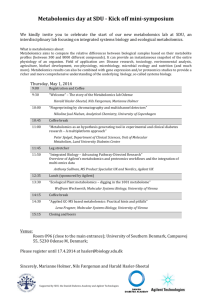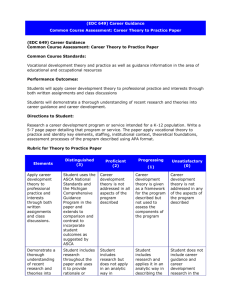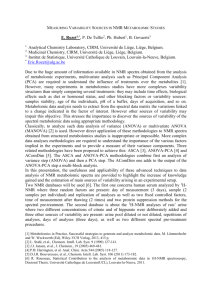Multi-factor and time-series data analysis
advertisement
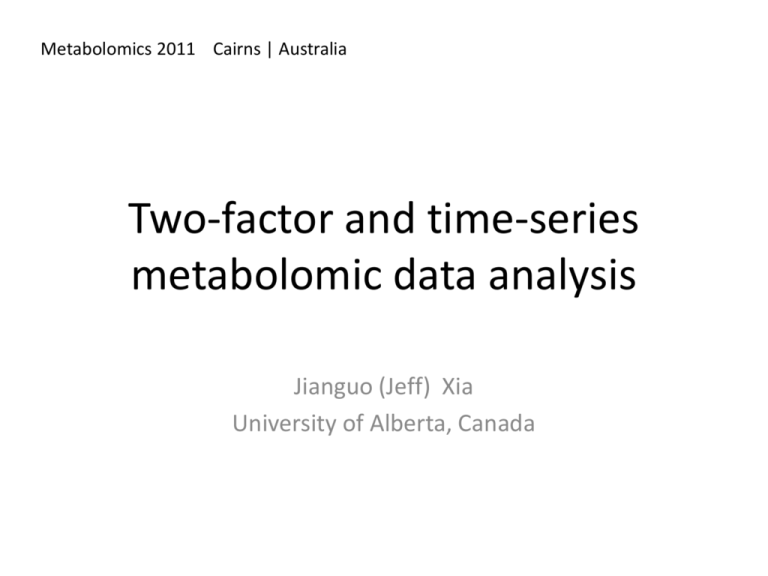
Metabolomics 2011 Cairns | Australia Two-factor and time-series metabolomic data analysis Jianguo (Jeff) Xia University of Alberta, Canada Metabolomics @ Univ. of Alberta • To establish infrastructure and to facilitate the application of metabolomics – Creating comprehensive, public accessible metabolomic databases o o o The Human Metabolome Database (HMDB) Drugbank, SMPDB MarkerDB, etc – Developing robust analytical protocols o o NMR, GC-MS, LC-MS, DI-MS The Metabolomics Innovation Center (TMIC) – Developing bioinformatics tools for metabolomics data analysis Bioinformatics Tools • MetaboAnalyst – General-purpose metabolomic data analysis pipeline • Raw data processing, normalization, statistical analysis … – http://www.metaboanalyst.ca • MSEA - metabolite set enrichment analysis – Identification of enriched groups of metabolites that are biologically meaningful • Associated with pathways, diseases, genetic traits …. – http://www.msea.ca • MetPA - metabolic pathway analysis – Identification of metabolic pathways that are most likely to be affected by or involved in the experimental conditions • Pathway enrichment analysis, topology analysis, visualization – http://metpa.metabolomics.ca Note, both enrichment analysis and pathway analysis can also be accessed from MetaboAnalyst Widely Used • > 25,000 visits world wide • ~ 100 jobs /day 4 GC/LC-MS raw spectra MS / NMR peak lists MS / NMR spectra bins • Peak detection • Retention time correction Metabolite concentrations Baseline filtering Peak alignment • Data integrity check • Missing value imputation Resources & utilities • Peak searching • Pathway mapping • Name conversion • Lipidomics • Metabolite set libraries Enrichment analysis • Over representation analysis • Single sample profiling • Quantitative enrichment analysis Data normalization • Row-wise normalization • Column-wise normalization Statistical analysis Pathway analysis • Enrichment analysis • Topology analysis • Interactive visualization • Univariate analysis • Dimension reduction • Feature selection • Cluster analysis • Classification Downloads •Processed data • PDF report • Images Time-series /two factor • Clustering • Two-way ANOVA • ASCA • Temporal Comparison Motivation • Metabolomics is very suitable for longitudinal studies – Relatively cheaper – Convenient sample collection (urine, saliva, blood, etc.) • Metabolome directly interacts with environment. It is subjected to the effects of various factors – Age, sex, life style ….. • We need bioinformatics tools for time-series and multi-factor metabolomic data analysis Project Overview • Objective – To develop a user-friendly web-based tool for analyzing time-series / multifactor metabolomic data • Target users – Experimental biologists looking for practical solutions to analyzing their data • Target experimental design – Time and group – General two-factor design Literature Survey • Common tasks – Identification of metabolites with similar patterns of change – Identification of metabolites with different patterns of change – Identification of global patterns of change • Commonly used approaches – – – – – Clustering approaches Linear model (i.e. LIMMA) ANOVA-based approaches (i.e. ASCA) Bayesian approaches (i.e. BATS) Other approaches …. • Smilde, A.K., et al. “Dynamic metabolomic data analysis: a tutorial review” Metabolomics (2010) 6:3–17 Clustering Technique • Goal: to identify metabolites with similar or correlated expression profiles • Methods: hierarchical clustering, Kmeans, SOM, etc Generated using Mfuzz package (L., Kumar and M., Futschik, 2007) Temporal Profile Analysis • Goal: to identify temporal profiles that are significantly different among different experimental conditions • Methods (TimeCourse): o Comparing time-course mean profiles of each metabolite o Taking consideration of both within and between time points variance ANOVA-based techniques (ASCA) • Goal: to identify major trends associated with each experimental factor • Method: two stages 1. Calculating main effects & interaction 2. PCA on each partition Which Methods? • Selection criteria (for web-based applications) – Underlying theory are generally understood (by biologists) – Algorithms well established • Not proprietary, preferably open-source (i.e. R code) • Not computationally prohibitive – Relatively straightforward to present Selected Methods • Univariate method – Two-way within/between-subject ANOVA • Clustering + visual exploration – Interactive 3D PCA – Two-way heatmap hierarchical clustering • Multivariate methods – ANOVA – simultaneous component analysis (ASCA) • Model selection • Model validation • Feature selection – Multivariate empirical Bayes time-series analysis (MEBA) http://metatt.metabolomics.ca You can also access from within MetaboAnalyst Input Format Time-series replicates Experimental conditions Interactive 3D PCA visualization Two-way clustered heatmap Two-way ANOVA ASCA – identification of major trends Smilde, A.K., et al. and Vis, D.J., et al. ASCA – variable selection • To identify significant variables that behave according to the detected patterns. – Leverage • Derived from loadings – Squared prediction error (SPE) • Derived from residuals • Nueda, et al., 2007 Temporal Profile Analysis • To detect variables with distinctive temporal profiles • The variables are ranked by MBstatistics • Tai, Y.C. and Speed, T.P. Analysis Report (PDF) Tips • Data should be centered (zero-means) and properly normalized before analysis • When there appear to be a strong interaction effect, the result need to interpreted in the context of each other; otherwise, it is advisable to analyzed the data with regard to each factor independently for ease of interpretation • Multi (> 2) factor data analysis can be decomposed into two-factor data analysis Summary • MetATT offers three commonly used approaches i. ii. iii. Identification of compounds with similar patterns - PCA, heatmap Identification of compounds with different temporal profile analysis - MEBA, ANOVA Identification of global major (and secondary) patterns - ASCA • Time-series and multi-factor omics data analysis is still at its early stages. – No well-defined procedures • Future efforts – Evaluate other approaches • PARAFAC, Tucker, N-PLS, etc – Challenges • Too complex to be presented on a web-based program • Lack of widely-accepted outputs & associated interpretations References • Smilde, A.K., et al. (2005) ANOVA-simultaneous component analysis (ASCA): a new tool for analyzing designed metabolomics data, Bioinformatics, 21, 3043-3048. • Tai, Y.C. and Speed, T.P. (2006) A multivariate empirical Bayes statistic for replicated microarray time course data, Annals of Statistics, 34, 23872412. • Vis, D.J., et al. (2007) Statistical validation of megavariate effects in ASCA, BMC Bioinformatics, 8, 322. • Nueda, M.J., et al. (2007) Discovering gene expression patterns in time course microarray experiments by ANOVA-SCA, Bioinformatics, 23, 17921800. • Glaab, E., et al. (2010) vrmlgen: An R Package for 3D Data Visualization on the Web, Journal of Statistical Software, 36, 2347-2348. Acknowledgements • • • • Dr. David Wishart Dr. Rupa Mandal Dr. Igor Sinelnikov Dr. David Broadhurst
